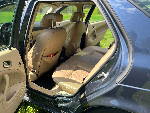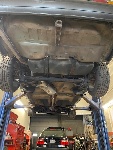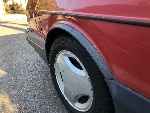
2003-2011 [Subscribe to Daily Digest] |
| [Main 93 Bulletin Board | BBFAQ |
Prev by Date | Next by Date | Post Followup ]
Member Login / Signup - Members see fewer ads. - Latest Member Gallery Photos
According to Tire Rack, New to the Rear (Long) Posted by Ian Glenday [Email]  [Profile/Gallery]
(more from Ian Glenday) on Tue, 5 Apr 2005 17:43:01 [Profile/Gallery]
(more from Ian Glenday) on Tue, 5 Apr 2005 17:43:01
In Reply to: Re: Good tires to the rear....., dmz789, Tue, 5 Apr 2005 17:05:51 Members do not see ads below this line. - Help Keep This Site Online - Signup |
Most vehicles are equipped with the same size tire at every wheel position. Ideally all of these tires should also be of the same type and design, have the same tread depth and be inflated to the pressures specified by the vehicle placard or owner's manual. This combination best retains the handling balance engineered into the vehicle by its manufacturer.
However due to the front tires' responsibility for transmitting acceleration, steering and most of the braking forces on front-wheel-drive vehicles, it's normal for front tires to wear faster than rear tires. If the tires aren't rotated on a regular basis, it's also common for pairs of tires to wear out rather than sets. And if the tires aren't rotated at all, it's likely that the rear tires will still have about 1/2 of their original tread depth when the front tires are completely worn out.
Intuition suggests that since the front tires wore out first and because there is still about half-tread remaining on the rear tires, the new tires should be installed on the front axle. This will provide more traction, and by the time the front tires have worn out for the second time, the rear tires will be worn out too. However in this case, intuition isn't right...and following it can be downright dangerous.
When tires are replaced in pairs in situations like these, the new tires should always be installed on the rear axle and the worn tires moved to the front. The reason is because new tires on the rear axle help the driver more easily maintain control on wet roads because new, deeper treaded tires are more capable of resisting hydroplaning.
Hydroplaning occurs when the tire cannot process enough water through its tread design to maintain effective contact with the road. In moderate to heavy rain, water can pool up in road ruts, depressions and pockets adjacent to pavement expansion joints. At higher speeds, the standing water often found in these pools challenge a tire's ability to resist hydroplaning.
Exactly when hydroplaning occurs is the result of a combination of elements including water depth, vehicle weight and speed, as well as tire size, air pressure, tread design and tread depth. A lightweight vehicle with wide, worn, underinflated tires will hydroplane at lower speeds in a heavy downpour than a heavyweight vehicle equipped with new, narrow, properly inflated tires in drizzling rain.
If the rear tires have more tread depth than the front tires, the front tires will begin to hydroplane and lose traction on wet roads before the rears. This will cause the vehicle to begin to understeer (the vehicle wants to continue driving straight ahead). Understeer is relatively easy to control because releasing the gas pedal will slow the vehicle and help the driver maintain control.
However, if the front tires have more tread depth than the rear tires, the rear tires will begin to hydroplane and lose traction on wet roads before the fronts. This will cause the vehicle to begin to oversteer in which the vehicle wants to spin. Oversteer is far more difficult to control, and in addition to the initial distress felt when the rear of the car starts sliding, quickly releasing the gas pedal in an attempt to slow down may actually make it more difficult for the driver to regain control, possibly causing a complete spinout.
Members of The Tire Rack team had the chance to experience this phenomenon at Michelin's Laurens Proving Grounds. Participants were allowed to drive around a large radius, wet curve in vehicles fitted with tires of different tread depths — one vehicle with new tires on the rear and half-worn tires on the front, and the other with the new tires in the front and half-worn tires on the rear.
It didn't take long for this hands-on experience to confirm that the "proving grounds" name for the facility was correct. The ability to sense and control predictable understeer with the new tires on the rear, and the helplessness in trying to control the surprising oversteer with the new tires on the front was emphatically proven.
And even though our drivers had the advantage of knowing we were going to be challenged to maintain car control, spinouts became common during our laps in the car with the new tires on the front. Michelin advises us that almost everyone spins out at least once!
Experiencing this phenomenon in the safe, controlled conditions of Michelin's Laurens Proving Grounds rather than in traffic on an Interstate ramp in a rainstorm is definitely preferred!
In case there is any doubt, when tires are replaced in pairs, the new tires should always be installed on the rear axle and the worn tires moved to the front.
Additional Tire Tech Articles Air Pressure, Temperature Fluctuations Air Pressure, Time Fluctuations Air Pressure vs. Dry Performance Air Pressure vs. Wet Performance Alignment Breaking In Your Tires Bridgestones's UNI-T Technology Calculating Tire Dimensions Checking Tire Inflation Pressure Construction Materials Contact Patch Determining the Age of a Tire Diagnosing Tire Pull Driving Through Tire Blowouts Firestone's UNI-T Technology Economic Commission for Europe (E.C.E.) How Do I Compare Price vs. Value? Hydroplaning: The Role Tires Play Match Mounting to Enhance Tire & Wheel Uniformity Matching Tires on Four-Wheel Drive and All-Wheel Drive Vehicles Michelin's C3M Process Mounting and Balancing North American Load and Pressure Markings Original Equipment (OE) Tires Original Equipment Tire Designations P-Metric and Euro Metric Tire Sizing Porsche N-Specification Tire Approvals Puncture Repairs Road Hazard Program Rolling Resistance Rubber Cracking Selecting the Right Tires Sidewall Indentations, Undulations and Protrusions Sidewall Markings Size Selection of Performance Tires (Plus Size, Inch-Up) Specific Mileage Warranties Speedometer Accuracy Speed Rating, Load Index & Service Descriptions Storing Tires Tire Flatspotting Tire & Wheel Owners Manual Tire & Wheel Package Installation Tire & Wheel Package Ride Uniformity Tire Aging Tire Pressure Monitoring Systems Tire Rotation Tire Size Conversion Chart Tire Size Information Tramlining: Coping with the Ruts in the Road Uniform Tire Quality Grade (UTQG) Standards Vibration Diagnosis Flow Chart Warranty When Should I Replace My Tires? Where to Install New Pairs of Tires? -- Light Truck Tires -- Diameter Comparison of Light Truck Tire Sizes Dual Tires for Light Truck Use Light Truck Fitment Formula Load Range/Ply Rating Identification Load Reduction of Euro- and P-Metric Tires on Light Trucks -- Run Flat Tires -- Run Flat Tires Testing the Dunlop SP Sport 9000 DSST -- Competition Tires -- Air Pressure for Competition Tires Care and Feeding of BFG g-Force R1 Tires Care and Feeding of the Kumho ECSTA V700 Care and Feeding of the Kumho V700 Victoracer Care and Feeding of the Michelin Pilot Sport Cup Care and Feeding of the Pirelli P Zero Corsa Getting More Out of Competition Tires Hoosier Racing Tire Tips Our Heat Cycling Service Shaving Tires for Competition Read Winter Tire Tech Articles
_______________________________________ Ian 1959 93b 1967 96V4 1968 99 1974 99L 1988 900S 1988 900 1994 900S 1996 900S 1999 9-5SE, 2.3lpt 1995 9000 CSE 2006 9-3SC, 2.0T
No Site Registration is Required to Post - Site Membership is optional (Member Features List), but helps to keep the site online
for all Saabers. If the site helps you, please consider helping the site by becoming a member.
 |
 |
 |
 |
 |



